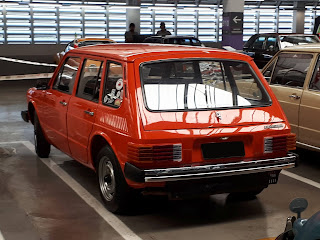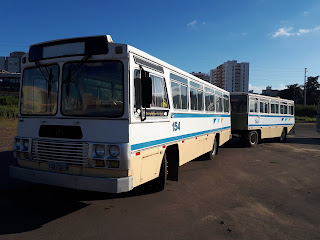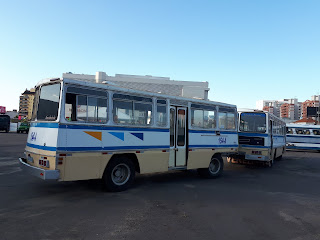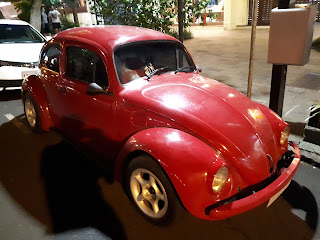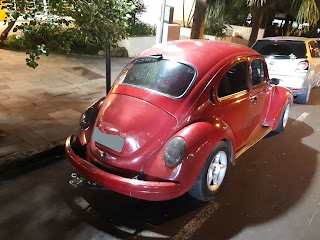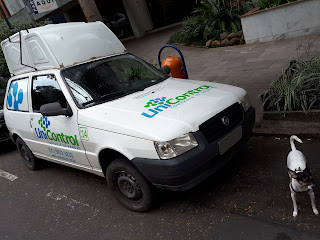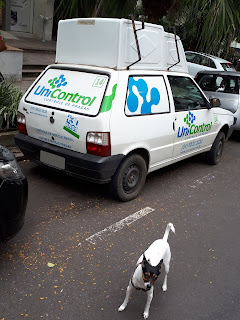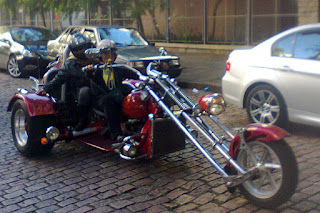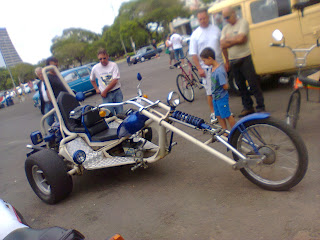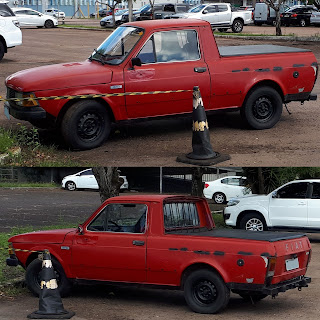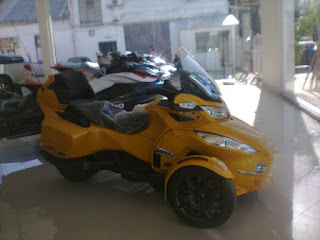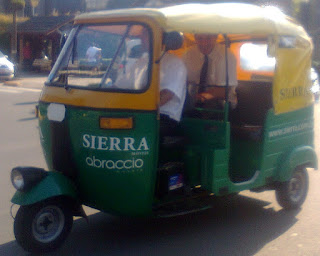One of the Brazilian air-cooled Volkswagens I like the most is the Brasília, which was made from '73 to '82, with a 4-door body available from '76 on which was actually more popular for export but also had its fair share of the market either in public fleets or as a taxi. This orange one might eventually have been a taxi in my hometown Porto Alegre. Most were fitted with the 1.6L version of the good old boxer engine, while some rare ethanol-powered 1.3L ones were also available in the late years. It was also produced in Mexico, but as a two-door only which is quite surprising since it was supposed to be a more favorable market to the 4-door bodystyle. CKD assembly happened in countries such as the Philippines, Nigeria, Uruguay and Argentina, while CBU exports reached regional markets like Peru, Bolivia, Venezuela, Ecuador, Paraguay and Chile, and even in Portugal it had been available.
The same boxer engines also served the earlier versions of the Gol, such as this '80 model which still resorted to the 1.3L engine. Rumors quote this to have been an attempt from Volkswagen to get rid of a stock of engines which were refused by export markets. The replacement for the 1.6L engine on the following year increased the performance to levels deemed more acceptable by the overwhelming majority of Brazilian customers, and the "BX" lasted until '86 when subsequent versions of the Gol were by then all fitted with water-cooled engines. A key difference to the Brasília is the fact that the Gol had the engine mounted upfront and with front-wheel drive.
Friday, November 23, 2018
Saturday, November 17, 2018
Ancient bus with matching trailer in my hometown
Before articulated buses became mainstream in Brazil, there were some unusual approaches, such as this trailer meant to be pulled behind a regular bus on peak hours. Made by Marcopolo and matching the design of its Veneza series of city buses, these trailers had their frames supplied by the Randon company which is well known for its semi-trailers and other truck implements. These were common in cities near my hometown Porto Alegre, at the intercity routes connecting Canoas, Alvorada and Cachoeirinha with Porto Alegre.
Sunday, November 11, 2018
Brazilian Beetle with a rear wiper and possibly a water-cooled engine swap
Spotted this red Beetle last Friday night. It's a '76, and it was originally fitted with the 1300 air-cooled boxer engine. However, taking a look behind it, the engine lid had a bump that may suggest it to have been swapped with some water-cooled straight-4 such as Volkswagen's EA827, and so it would need clearance to fit the longer cylinder head which also sits taller. The slots on the lid itself and the ones between it and the rear window were shut, so it's uncertain how the air intake gets on its way to the carburettor. The radiator might have been mounted sideways between the engine and one of the rear wheels, which is not an unusual approach for Beetle-based vehicles converted to some water-cooled engine in Brazil.
However, the feature that has caught my attention more than any other was the rear wiper, which I was aware of some Beetles that had one adapted but never seen one personally before. Didn't really expect it to hang above the rear window instead of below, which is a more usual position for it on vehicles originally fitted with one. Apart from this Beetle, the only vehicle I can recall having the rear wiper hanging from above is the Range Rover Evoque.
However, the feature that has caught my attention more than any other was the rear wiper, which I was aware of some Beetles that had one adapted but never seen one personally before. Didn't really expect it to hang above the rear window instead of below, which is a more usual position for it on vehicles originally fitted with one. Apart from this Beetle, the only vehicle I can recall having the rear wiper hanging from above is the Range Rover Evoque.
Wednesday, November 07, 2018
'07 Honda CG 150 Job with a car-type receiver hitch
At a first glance, this Honda CG 150 Job may look like any other which still roams around Brazil, but it had been fitted with a rather unusual feature. It has been fitted with a car-type receiver hitch to tow a small trailer, requiring a supporting structure to be added to its chassis. I have been used to see similar setups for a while during my childhood, but haven't seen so many of those for the last 16 years due to the increasing popularity of cargo sidecars and the lack of a regulation for towing with motorcycles until some years ago. Nowadays the most usual receiver hitch setup for motorcycles is bolted to the rear suspension swing-arm. Spotted this one yesterday in my hometown Porto Alegre.
Tuesday, November 06, 2018
Are tricycles more prone to become a viable replacement for commercial vehicles than they would for private cars?
Tricycles are often treated as somewhat "inferior" to a conventional car, much like the motorcycles they might be based upon, and unfortunately the status plays a crucial role when it comes to private vehicle ownership. On the other hand, when it comes to commercial vehicles, the functionality and a low operating cost become more relevant to the point that some compromises become less relevant. So, even though there might be some fierce resistence to proposals of resorting to tricycles as a way to increase the pace of fleet renewal in 3rd-world countries, it would be pointless to exclude them at all from such process.
Resale value is still a matter of concern too, and sometimes even a passenger car such as a Fiat Uno or a commercial derivative might be prefered because of this factor alone, considering they're more of an off-the-shelf solution, and that would lead to an easier search for replacement parts when needed. Other than that, the fact that a more conventional vehicle is not so restricted when it comes to speed in comparison to some motorcycle-based trike with an engine considerably smaller also often sounds attractive in case the operator needs to perform some service in different places which would be more easily accessible through a highway.
Sure there will be a wider acceptance for private tricycles among certain users, not only recreational ones who frequently resorted to Volkswagen-based mechanicals, but it becomes somewhat specific. A segment of the market that could be served quite right with motorcycle-based models is represented by disabled drivers/riders who look out for private vehicle ownership more as a matter of necessity than luxury. Even though some amenities could be missing, there are users who put more value on an ease to find parking spots and maneuver on tight spaces, and then both a more affordable price and a lower fuel consumption compared to a car become a much valuable asset.
The increasing popularity of the use of commercial vehicles for private purposes, which may embrace even older ones such as an early Fiat Fiorino and also resembles to some extention the obsession for pick-up trucks in the United States, could also sound like a cultural barrier against the move toward tricycles as an effective replacement to ancient (and often not in their best shape) 4-wheeled vehicles in general. It may not prevent strictly commercial operators to be more open-minded for a shift in the middle of their struggle to retain or increase profitability. Another point to consider is the influence of China in some export markets, which may deem a Chinese tricycle with a fully-enclosed cabin and a flatbed as a good alternative to something else more complex.
Roadworthy certification and licensing requirements for motor vehicles may eventually turn into an obstacle too. The dual-airbag mandate for new 2WD vehicles (or single-range 4WD/AWD) with a payload lower than one metric ton in Brazil, enforced since 2014 when ABS brakes also became mandatory for every new car, LCV, truck and bus, rendered it nearly impossible to certify tricycles such as those electric ones imported by Hedesa (and their motorcycle-engined counterparts for those who wouldn't get rid of an internal-combustion engine so soon) with a car-like cockpit and side-by-side seating locally. Another approach that could be taken would be certifying such vehicles as agricultural machinery, which was the strategy used by the businessman Paulo Emílio Freire Lemos to circumvent safety requirements and allow the conditional registration of some Diesel-powered Chinese tricycles which he imported and sold as Gurgel TA-01. However, since in Brazil a commercial driver's license is required to operate tractors on public roads, it would become impossible for the average Joe to legally roam around in one of those...
In the end, no matter if it's as fancy as a Can-Am Spyder RT-S or as bare-bones as those Bajaj-made Indian derivatives of the Piaggio Ape, tricycles are most often considering too "specialized" to meet the versatility requirements of the entry-level car market. It becomes crucial to address the needs of a family that may afford to own only one vehicle, and this is where most of the options on the market still fail. So, despite eventually having some advantages that could be better explored on passenger transport duties, it's still more likely for tricycles to succeed on cargo duties.
Resale value is still a matter of concern too, and sometimes even a passenger car such as a Fiat Uno or a commercial derivative might be prefered because of this factor alone, considering they're more of an off-the-shelf solution, and that would lead to an easier search for replacement parts when needed. Other than that, the fact that a more conventional vehicle is not so restricted when it comes to speed in comparison to some motorcycle-based trike with an engine considerably smaller also often sounds attractive in case the operator needs to perform some service in different places which would be more easily accessible through a highway.
Sure there will be a wider acceptance for private tricycles among certain users, not only recreational ones who frequently resorted to Volkswagen-based mechanicals, but it becomes somewhat specific. A segment of the market that could be served quite right with motorcycle-based models is represented by disabled drivers/riders who look out for private vehicle ownership more as a matter of necessity than luxury. Even though some amenities could be missing, there are users who put more value on an ease to find parking spots and maneuver on tight spaces, and then both a more affordable price and a lower fuel consumption compared to a car become a much valuable asset.
The increasing popularity of the use of commercial vehicles for private purposes, which may embrace even older ones such as an early Fiat Fiorino and also resembles to some extention the obsession for pick-up trucks in the United States, could also sound like a cultural barrier against the move toward tricycles as an effective replacement to ancient (and often not in their best shape) 4-wheeled vehicles in general. It may not prevent strictly commercial operators to be more open-minded for a shift in the middle of their struggle to retain or increase profitability. Another point to consider is the influence of China in some export markets, which may deem a Chinese tricycle with a fully-enclosed cabin and a flatbed as a good alternative to something else more complex.
Roadworthy certification and licensing requirements for motor vehicles may eventually turn into an obstacle too. The dual-airbag mandate for new 2WD vehicles (or single-range 4WD/AWD) with a payload lower than one metric ton in Brazil, enforced since 2014 when ABS brakes also became mandatory for every new car, LCV, truck and bus, rendered it nearly impossible to certify tricycles such as those electric ones imported by Hedesa (and their motorcycle-engined counterparts for those who wouldn't get rid of an internal-combustion engine so soon) with a car-like cockpit and side-by-side seating locally. Another approach that could be taken would be certifying such vehicles as agricultural machinery, which was the strategy used by the businessman Paulo Emílio Freire Lemos to circumvent safety requirements and allow the conditional registration of some Diesel-powered Chinese tricycles which he imported and sold as Gurgel TA-01. However, since in Brazil a commercial driver's license is required to operate tractors on public roads, it would become impossible for the average Joe to legally roam around in one of those...
In the end, no matter if it's as fancy as a Can-Am Spyder RT-S or as bare-bones as those Bajaj-made Indian derivatives of the Piaggio Ape, tricycles are most often considering too "specialized" to meet the versatility requirements of the entry-level car market. It becomes crucial to address the needs of a family that may afford to own only one vehicle, and this is where most of the options on the market still fail. So, despite eventually having some advantages that could be better explored on passenger transport duties, it's still more likely for tricycles to succeed on cargo duties.
Subscribe to:
Comments (Atom)

